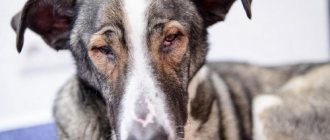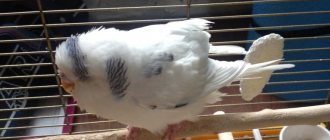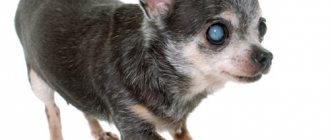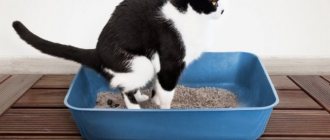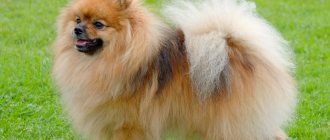The nose of a healthy dog
- The tip is cold.
- Moderately humid.
- The exhaled air is uniform, of medium strength and symmetrical from both nostrils.
- The color of the mucous membrane is pale pink, changing to pink-red when excited.
- No cuts or cracks.
- No swelling, overlays or ulcers.
- No discharge (snot).
Dryness is explained by limited sweat production or its complete cessation.
A decrease in the secretion of glands can occur in diseases that occur with a large loss of water from the body. Wet and cold skin becomes dry and hot (cold) to the touch, and with prolonged illness, cracks and crusts appear.
What does it mean if a dog has a dry nose?
If the pet is cheerful, feels good, does not refuse food and walks, and is generally playful and happy, then dry mucous membranes should not cause fear, doubt or worry. Most likely, everything is fine with your pet. Typically, the mucous membrane dries out in most dogs in hot weather, when it is very hot, there is not enough moisture.
Nowadays this happens mainly in dogs that are kept outside, and sometimes they forget to add water. Often it is the lack of water that causes dry mucous membranes. This indicates that the dog is in the early stages of dehydration, which is why the mucous membranes are drying out. What does it mean if a dog has a dry nose? In hot weather, if your dog has a dry nose, be sure to provide an additional container of water.
Cute pet
Possible causes of dry nose
- A dog's nose may become dry if the room temperature is too high (heat). Also, at excessively low temperatures (frost, wind), dry skin will be noted.
- During sleep, the animal's body temperature rises, i.e. becomes higher than normal, which leads to evaporation of moisture.
- If you were engaged in training or outdoor games with the dog.
- In puppies or in mature dogs. But, you need to take into account that in old age, dryness in a dog can lead to tissue diseases, which occurs due to metabolic disorders, and this is already a pathological case.
- Change of place of residence, environment or experience of shock in animals.
- Dryness can be passed on from generation to generation.
- During estrus, pregnancy and feeding puppies, the reason is hormonal changes in the body.
- A poorly designed diet that contains a lack of any microelements, vitamins and minerals.
- Insufficient fluid intake.
- Species, gender, age, different metabolism and much more.
All the reasons described above should lead to dryness for a short period of time, no more than two hours.
If the manifested symptom does not disappear, or, moreover, additional symptoms appear that are not inherent in the normal and healthy behavior of the animal, then this indicates unfavorable, pathological changes in the dog’s body.
Why does a dog have a dry nose? Reasons
Accordingly, in order to find out whether a dog is sick with something or not, it is necessary not only to evaluate the dryness of the tip of the muzzle, but also how he feels in general, there are no suspicious symptoms. If a pet suffers from vomiting, is restless, does not eat well, but its mucous membranes are wet, this is a sign of a disease, so you should not focus only on the moisture content of the tip of the muzzle.
Why does a dog have a dry nose, reasons:
- Oddly enough, our pets can suffer from allergies, just like people. Accordingly, in early spring, when plants are just beginning to bloom, the dog may experience dry mucous membranes. There may not be any additional symptoms.
- Most often, it is precisely because a wet nose attracts all sorts of allergens that it becomes dry to maintain health. It is necessary to pay attention to the weather, not only hot, but also cold. In frosty times, when there is a strong squall wind, the pet’s mucous membranes are dry and warm. This is due to the fact that a wet nose can become covered with an icy crust; therefore, the drying of the secretion in such conditions is a natural phenomenon in order to protect the dog from various ailments.
- Allergies in dogs can be caused not only by plant pollen, but also by some objects used in the feeding process. These can be bowls, as well as rodents made from low-quality silicone or plastic. Both people and dogs can be allergic to cheap Chinese plastic.
Cutie
Symptoms of pathological diseases
The symptom of dry nose in pathological conditions and diseases of the animal’s body does not appear alone. Along with it, various kinds of symptoms appear, depending on the type of disease, such as:
- low and high apical temperatures;
- loss of appetite;
- lethargy;
- redness of the eyes;
- violations of integrity (cracks, ulcerations, swelling);
- expiration;
- sneezing;
- cough and many others.
It is necessary to take into account that the “collection” of some symptoms may indicate either one specific disease or several completely different ones.
The main causes of pathological diseases and their symptoms:
1. Spending time outside or in the house, a dog can introduce a foreign body into its body, or cause injury (dry and hot nose).
2. With an insufficient amount of fluid entering the body, the dog can easily be led to a pathological condition (dry and hot nose).
3. If there is severe loss of fluid, for example with vomiting, frequent urination, or loose stools, dehydration will also occur (dry nose, lethargy and high temperature).
4. Some types of allergies in dogs: food, to flea saliva or to environmental substances (dry nose, snot, red eyes).
5. Lack of vitamins in dogs is expressed in the form of vitamin deficiency and hypovitaminosis (dry and cracked nose, lethargy).
6. Intake of toxins (dry and hot nose, lethargy).
7. Infection with helminths and their eggs (lethargy and dry nose).
8. In case of infection (dry and hot nose, snot flowing).
9. Autoimmune skin disease (papules and pustules, erosions and yellow crusts form, a cracked nose, the dog does not eat and the nose is dry).
10. Canine distemper (redness of the eyes, the dog’s nose becomes dry and flaky).
11. Interstitial nephritis (dry and hot nose).
12. The postoperative period may involve dehydration (dry and hot nose).
What should a dog's nose be like?
If the dog is active, its nose is usually wet. It is the moisture that makes it cold at the same time. During normal functioning, the animal's body produces tears that flow into the nostrils through the nasolacrimal ducts. The dog senses them and intuitively licks his nose.
Does a warm and dry nose mean that the dog is sick? This is a very individual matter. The fact is that this may be a sign of illness. It's also good to know how your dog's allergies manifest themselves. Sometimes, however, it turns out that the four-legged animal is healthy and this is due to the reasons given above.
Prevention
In order to avoid the risk of disease, you need to know about the preventive measures that the owner himself can carry out and support. The most important thing is to always be attentive to your pet and take proper, complete and proper care of it.
- It is necessary to monitor walking areas located outside the living quarters. Dirt is a kind of storage and cause of various kinds of infections and parasitic diseases. There may be debris, metal objects, glass shards, plastic that the dog can eat or injure itself.
- It is necessary to control contacts with other animals: stray dogs, cats, hedgehogs. These are potential carriers of infections and diseases, and in some cases, they can infect a dog with rabies.
- If the weather is hot, then reduce the time you spend outside, or find a place where direct sunlight will not penetrate.
- Always have a bottle of water with you so that your pet can always quench its thirst.
- Try not to take your dog to places where there may be sources of allergies.
- If the time of winter weather has come, then you should reduce your time spent outdoors, or use special clothing for animals.
- After a walk, you should always bathe the animal to destroy pathogenic microflora brought with dirt.
- Create a comfortable temperature in the room and eliminate drafts. Monitor the cleanliness and hygiene of the premises and ensure a favorable environment.
- The dishes must be clean, food and water must be fresh, of high quality and properly selected.
- Change the water every day and make sure there is always plenty of it.
- And most importantly, carry out annual vaccination and deworming (anthelminthic therapy) of your pet. To do this, you need to contact a veterinary clinic so that the doctor examines the animal and advises the owner about everything that concerns his dog.
Additional symptoms, their explanation and what to do
In some cases, a dry and hot nose in a puppy can actually be a symptom of poor health. It is important to understand that judging a pet’s well-being only by the condition of its nose is incorrect. If your dog is sick, you will notice accompanying symptoms.
Below we will look at additional symptoms, their explanation and what to do if your puppy is sick.
Nose is very hot
If you feel like your nose is very hot, you need to:
- To make sure your puppy doesn't have a fever, the only reliable method is to measure the temperature with a thermometer.
- Make sure that the puppy does not overheat - overheating is possible in hot weather, after serious physical exertion, during the heating season.
Temperature is measured by inserting a thermometer into the anus. To avoid overheating in winter, the puppy's bed should be located away from heating radiators.
Nose is very cold
If you feel that your nose is very cold, you need to:
- Examine the mucous membranes of the mouth and eyes - whitish and/or bluish color of the mucous membranes is a symptom of oxygen starvation of the body. There are dozens of causes of hypoxia, so if you find pale mucous membranes, you need to look for additional symptoms.
- Make sure that the puppy is not cold - hypothermia is accompanied by low temperature of the limbs and body, tremors, and apathetic state.
- Make sure that the puppy is not in a state of stress or shock - stress can arise as a result of any atypical situations. A state of shock can accompany a severe allergic reaction or be a complication after vaccination or taking medications.
It is important to understand that normally, the puppy’s nose should be cold and noticeably moist. The nose may seem very cold if the dog ran, swam, played, tried to smell some smells, or often licked its face.
Dry nose while sleeping
As mentioned above, a dry nose during sleep is normal. To make sure that your pet is healthy, you need to monitor its condition. A healthy dog has a good appetite, remains active, and is willing to go for walks.
If a pet has become infected with an infectious or viral disease, during the incubation period, the temperature can rise only during sleep. In the absence of vaccination, if you notice that the puppy’s nose dries out during sleep for several days in a row, you need to “play it safe.” At a minimum, measure your pet’s temperature immediately after waking up; if it is elevated by no more than 0.5-1 degrees, there is nothing to worry about.
The puppy doesn't eat anything
If your puppy doesn't eat anything and has a dry nose, the reason may be:
- Increase in base body temperature.
- Poisoning.
- Dehydration.
Regardless of the reasons why your puppy refuses to eat, it is important to remember that it is safe to go hungry for 12 hours. If your puppy's condition worsens, he starts vomiting, has diarrhea, his mucous membranes turn pale, or he refuses water, contact your veterinarian immediately.
The puppy is lethargic
If the puppy is lethargic and has a dry nose, the reasons may be:
- A recent awakening.
- Overworked.
- Meteorological dependencies.
- Increased body temperature.
Lethargy and apathy are different symptoms. When a puppy is apathetic, he does not respond to his name, ignores his owner, treats, and appears very distant. In this case, you must immediately contact a veterinary clinic. If you observe a slight decrease in activity in the puppy, there is no need to worry in advance; give the baby the opportunity to sleep and monitor his body temperature.
Note! Weather dependence is rare in dogs. Miniature dogs and especially representatives of the Chihuahua breed are at risk.
The puppy is vomiting
A dry nose and vomiting may indicate:
- Poisoning.
- Dizziness.
- A disease of viral or infectious origin.
It is important to understand that dry mucous membranes and vomiting are related. Vomiting leads to increased consumption of water, that is, it causes dehydration. If the puppy has been vomiting for a long time, and then the nose becomes dry, the reason is a lack of water in the body.
The puppy has diarrhea
Similar to the above, when a puppy has diarrhea, the risk of dehydration increases. If nasal dryness is observed due to prolonged diarrhea, symptomatic treatment consists of drinking or subcutaneous administration of buffer solutions.
If dry nose and diarrhea occur simultaneously, there are two possible causes: intoxication or infectious infection. Intoxication can occur due to poisoning, elevated body temperature, improper functioning of the kidneys or liver.
The puppy has rapid breathing
Dry nose and rapid breathing can occur for the following reasons:
- The puppy is hot.
- Excitement, stress, aggression, fear or other strong emotions.
- Hypoxia.
- Fever.
During hypoxia, against the background of rapid but shallow breathing, pallor of the mucous membranes is observed. With a fever, the puppy breathes quickly, abruptly, superficially, and looks apathetic and weak.
The puppy is shaking all over
If the puppy is trembling all over and has a dry nose, the reasons may be the following:
- Violation of water-salt or water-electrolyte balance can provoke both mild tremors and serious convulsions.
- Hypothermia.
- Powerful emotions.
- Severe physical pain.
When hypothermia occurs, the puppy’s body temperature decreases, and the indicator may drop slightly. Tremor, against the background of severe physical pain, is accompanied by a lack of appetite and the puppy’s desire to hide.
The puppy has a runny nose and snot flowing
Quite often, owners are faced with an ambiguous situation: the puppy has a dry nasal surface, but a runny nose and snot.
These symptoms indicate infection:
- Infectious disease – very often.
- Viral disease - often if the puppy has not received vaccination.
- Fungal disease – rare.
Infectious diseases, including the common cold, are transmitted by airborne droplets, so a puppy can become infected while walking, at home, when visiting a veterinary clinic, etc. Infectious diseases are unpleasant, but not fatal if diagnosed and treated promptly.
Viral diseases are deadly because most of them have no effective treatment. Once infected, the puppy quickly and acutely develops specific symptoms that can only be alleviated by aggressive therapy. The puppy's survival depends only on the body's potential endurance.
If there is a fungal infection of the nasal sinuses, the puppy may experience whitish, thick snot with a specific odor. To eliminate the problem, specialized treatment is required, which is prescribed only when the diagnosis is confirmed by laboratory analysis of sinus swabs.
The puppy has a fever
Fever and dry nose in a puppy are interrelated phenomena. It is important to understand that both natural and pathological factors can contribute to an increase in temperature.
Natural causes include overwork, hot weather, prolonged deep sleep, severe agitation and evening time. A natural increase in temperature does not cause the pet to feel unwell, but it does affect the condition of the mucous membranes. With a pathological increase in temperature, the puppy experiences accompanying symptoms.
Complications after vaccination - what to look out for?
Modern vaccine manufacturers emphasize that vaccinations should not cause any side effects. However, even the safest vaccination involves introducing a weakened virus into the puppy’s body.
There are no ways to determine individual sensitivity or hypothetical consequences of vaccination, so you need to prepare for common complications after vaccination:
- A severe allergic reaction is observed very rarely and leads to Quincke's edema. An allergic reaction, which can threaten the pet's life, occurs within 10-30 minutes after the vaccine is administered. During this period of time, it is recommended to remain in the veterinarian's office.
- A slight increase in temperature is usually accompanied by a deterioration in appetite and a decrease in activity, against the background of normal water consumption.
In rare cases, if the dog has a sensitive digestive tract or dysbiosis, diarrhea may occur after vaccination. The condition is treated with safe adsorbents and enveloping agents (Enterosgel, Smecta).
Treatment
In case of injury. It is necessary to stop the bleeding. Identify the cause and location of the injury and disinfect the area. If necessary, administer anesthetic and apply stitches. Take medication that will promote further healing. Preparations: Lysozyme, Travmatin, Ranosan, etc.
When dehydrated. Force drink water using a syringe. Apply a dropper with glucose solution. If necessary, then medications.
For allergies. If you have a food allergy, then choose a diet that excludes those foods that cause an allergic reaction. If you are allergic to fleas, use collars and special shampoos. With Atopic allergies, the animal cannot be cured, but with the use of certain medications, vital signs can be improved. Medicines: Antihistamines.
With vitamin deficiency. Review and recalculate the animal’s diet, balancing it.
In case of poisoning. It is possible to wash the gastrointestinal tract with potassium permanganate. Preparations: vitamin B6, adsorbents.
For helminths. Anthelmintics.
For colds. Depending on the type of cold, take certain medications. Medicines: antibiotics, vitamins, immunostimulants, anti-inflammatory and expectorants.
Pet owners should understand that self-medicating their pet is very dangerous, this can lead to a deterioration in its condition, or, in the worst case, death.
Briefly about the main thing
- A healthy dog's nose is cold and moderately moist.
- Dryness is explained by limited sweat production or its complete cessation, but does not always signal illness.
- The symptom of dry nose in pathological conditions and diseases of the animal’s body does not appear alone.
- To prevent the risk of disease, you need to regularly monitor walking areas, the amount of fluid consumed, and also prevent overheating or hypothermia.
- If a problem occurs, you should immediately contact a specialist.
Alarming symptoms
Researchers have shown that a dog's nose changes temperature regularly throughout the day. Your dog's nose may be cold and wet one part of the day, but later in the day the nose may be dry and hot. In any case, he can be happy and healthy, or sick.
The following signs and symptoms may indicate illness:
- He doesn't drink;
- He's not acting normal;
- he whines;
- he is lethargic;
- He doesn't eat;
- Nasal discharge is colored and may have an odor;
- sneezing;
- cough;
- wheezing.
These are symptoms that should always be checked by your veterinarian. And if your dog's nose is really hot, then it's time to check if he has a fever. If so, call your veterinarian and make an appointment.
© shutterstock
